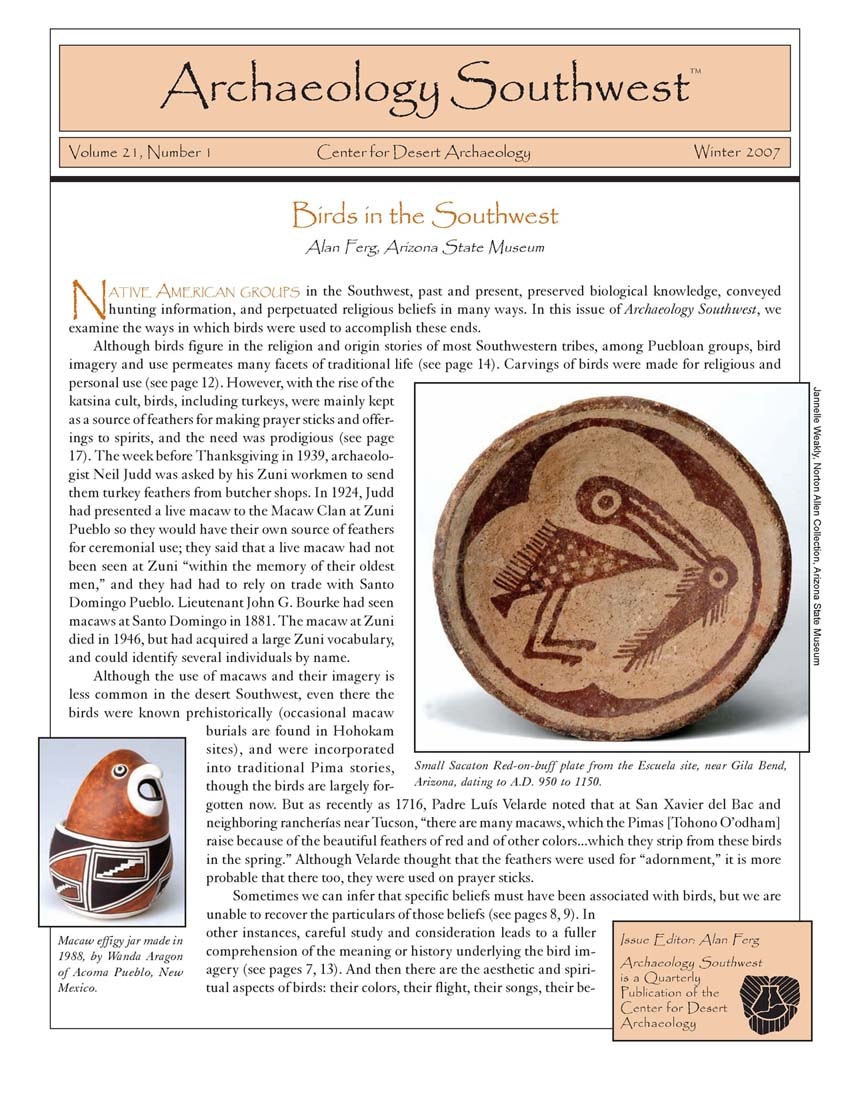Birds in the Southwest

Small Sacaton Red-on-buff plate from the Escuela site, near Gila Bend, Arizona, dating to A.D. 950 to 1150. Photo by Jannelle Weakly, Norton Allen Collection, Arizona State Museum.
Archaeology Southwest Magazine Vol. 21, No. 1
FREE PDF DOWNLOAD
Issue editor: Alan Ferg, Arizona State Museum
Native American groups in the Southwest, past and present, preserved biological knowledge, conveyed hunting information, and perpetuated religious beliefs in many ways. In this issue, we examine the ways in which birds were used to accomplish these ends.
Although birds figure in the religion and origin stories of most Southwestern tribes, among Puebloan groups, bird imagery and use permeates many facets of traditional life. Carvings of birds were made for religious and personal use. However, with the rise of the katsina cult, birds, including turkeys, were mainly kept as a source of feathers for making prayer sticks and offerings to spirits, and the need was prodigious. The week before Thanksgiving in 1939, archaeologist Neil Judd was asked by his Zuni workmen to send them turkey feathers from butcher shops. In 1924, Judd had presented a live macaw to the Macaw Clan at Zuni Pueblo so they would have their own source of feathers for ceremonial use; they said that a live macaw had not been seen at Zuni “within the memory of their oldest men,” and they had had to rely on trade with Santo Domingo Pueblo. Lieutenant John G. Bourke had seen macaws at Santo Domingo in 1881. The macaw at Zuni died in 1946, but had acquired a large Zuni vocabulary, and could identify several individuals by name.
Although the use of macaws and their imagery is less common in the desert Southwest, even there the birds were known prehistorically (occasional macaw burials are found in Hohokam sites), and were incorporated into traditional Pima stories, though the birds are largely forgotten now. But as recently as 1716, Padre Luis Velarde noted that at San Xavier del Bac and neighboring rancherias near Tucson, “there are many macaws, which the Pimas [Tohono O’odham] raise because of the beautiful feathers of red and other colors … which they strip from these birds in the spring.” Although Velarde thought that the feathers were used for “adornment,” it is more probable that there too, they were used on prayer sticks.
The articles in this issue look at birds from a variety of perspectives and disciplines, including those of archaeology, ethnology, ornithology, DNA analysis, material culture studies, iconographic analysis, and applied anthropology. Taken together, the articles presented here demonstrate that the relationships between birds and humans in the Southwest have been longstanding and complex, with aspects both secular and ceremonial.
Articles include:
Birds in the Southwest — Alan Ferg, Arizona State Museum
Ostriches in the Southwest — Alan Ferg, Arizona State Museum
Domestic Turkeys at Casas Grandes — Charmion R. McKusick, Southwest Bird Laboratory
Casas Grandes Macaws — Charmion R. McKusick, Southwest Bird Laboratory
Ancient DNA and Prehistoric Macaws — Peter Y. Bullock, White Sands Missile Range
The FaunAZ Project — Barnet Pavao-Zuckerman, Arizona State Museum
The Poorwill in Pima Oral Traditions — Amadeo M. Rea, University of San Diego
Birds and Serpents in Hohokam Art — Henry D. Wallace, Desert Archaeology, Inc.
Birds and Turquoise — Alan Ferg, Arizona State Museum
Lyndon Lane Hargrave, 1896–1978 — Steven D. Emslie, University of North Carolina Wilmington
Birds and Prehistoric Agriculture at Four New Mexico Pueblos — Steven D. Emslie, University of North Carolina Wilmington
Bird Iconography in Pueblo Art — Mark Bahti, Bahti Indian Arts
Monster Birds — Barton Wright
Hopi and Ancestral Hopi Bird Imagery — Kelley Hays-Gilpin, Northern Arizona University and Museum of Northern Arizona
Birds as Pets — Alan Ferg, Arizona State Museum
Ritual Use of Birds as a Marker of Ancient Immigrants — Patrick D. Lyons, Arizona State Museum and Center for Desert Archaeology
Zuni Prayer Sticks: Research by Edmund J. Ladd — Tobi Taylor, Center for Desert Archaeology
The Feather Distribution Project — Jonathan E. Reyman, Illinois State Museum
The Great Mesa Verde Turkey Experiment — Tobi Taylor, Center for Desert Archaeology
Back Sight — William H. Doelle, Center for Desert Archaeology
Subscribe

